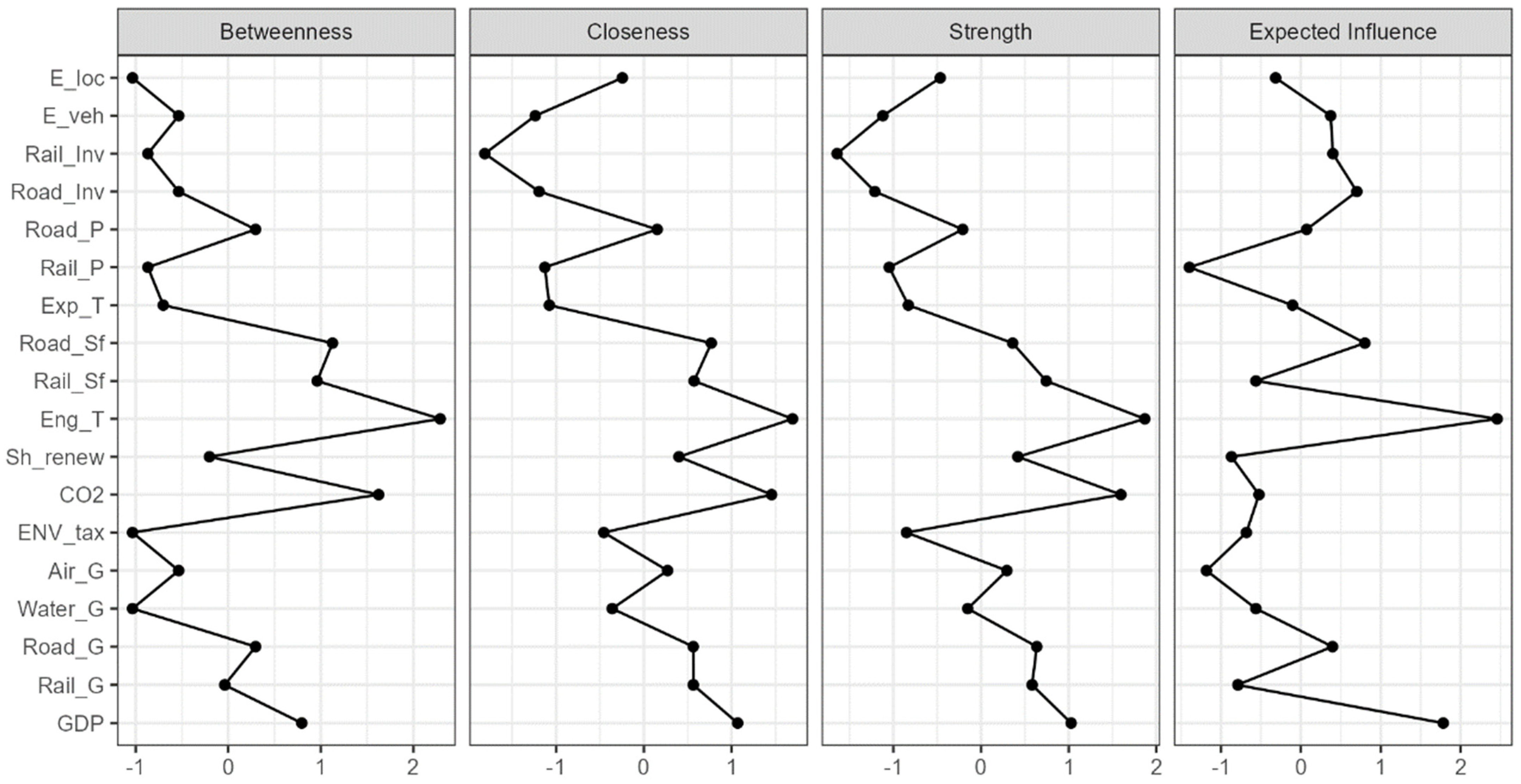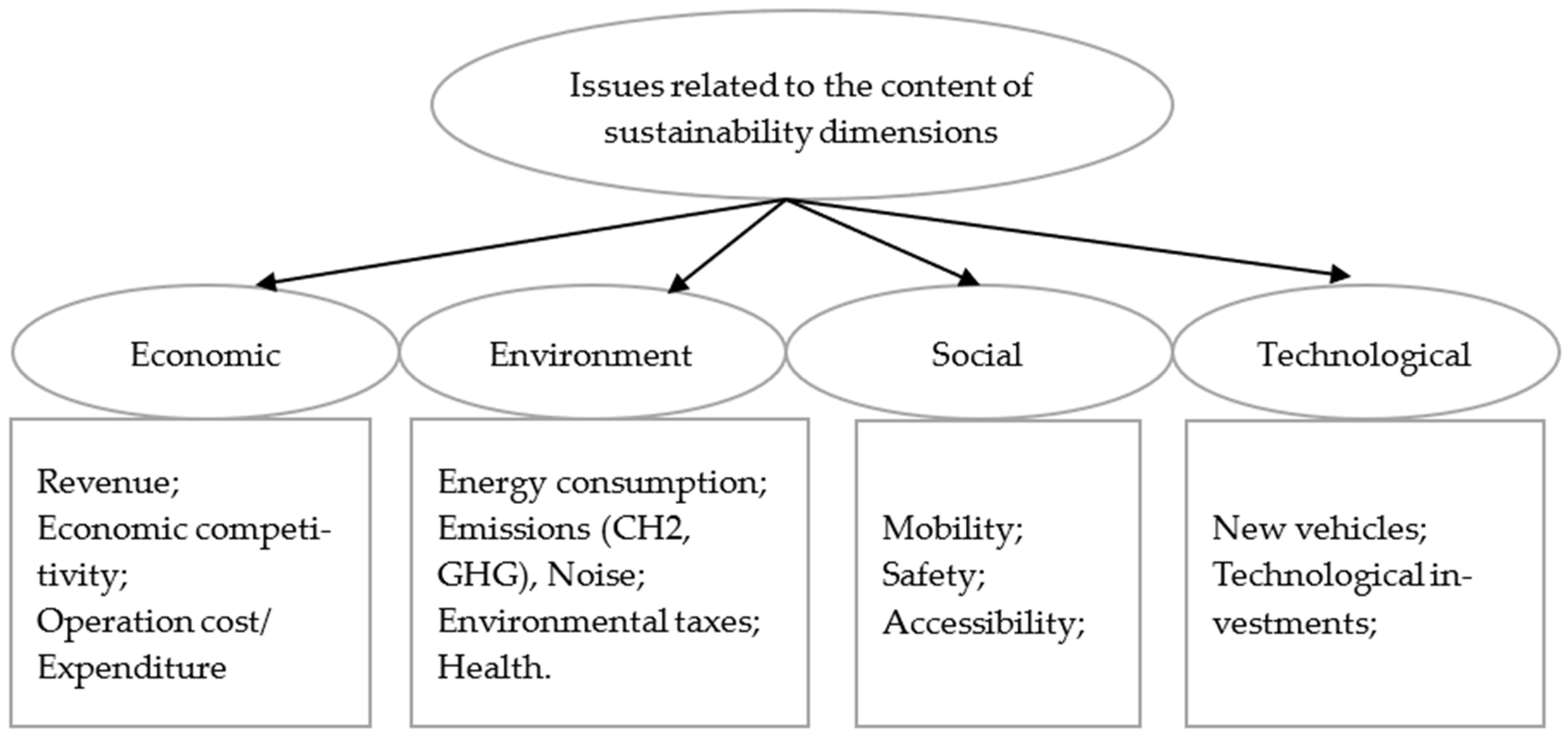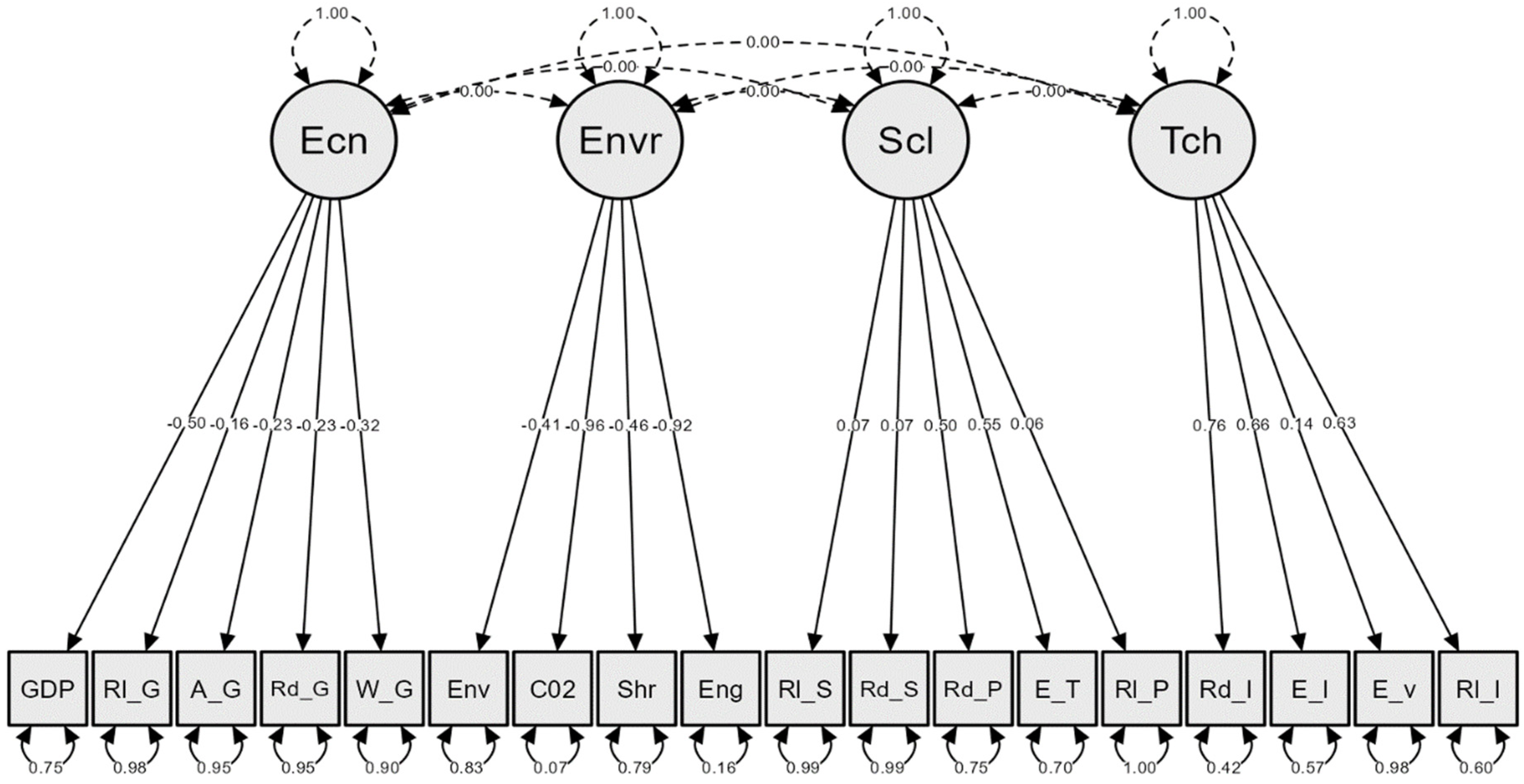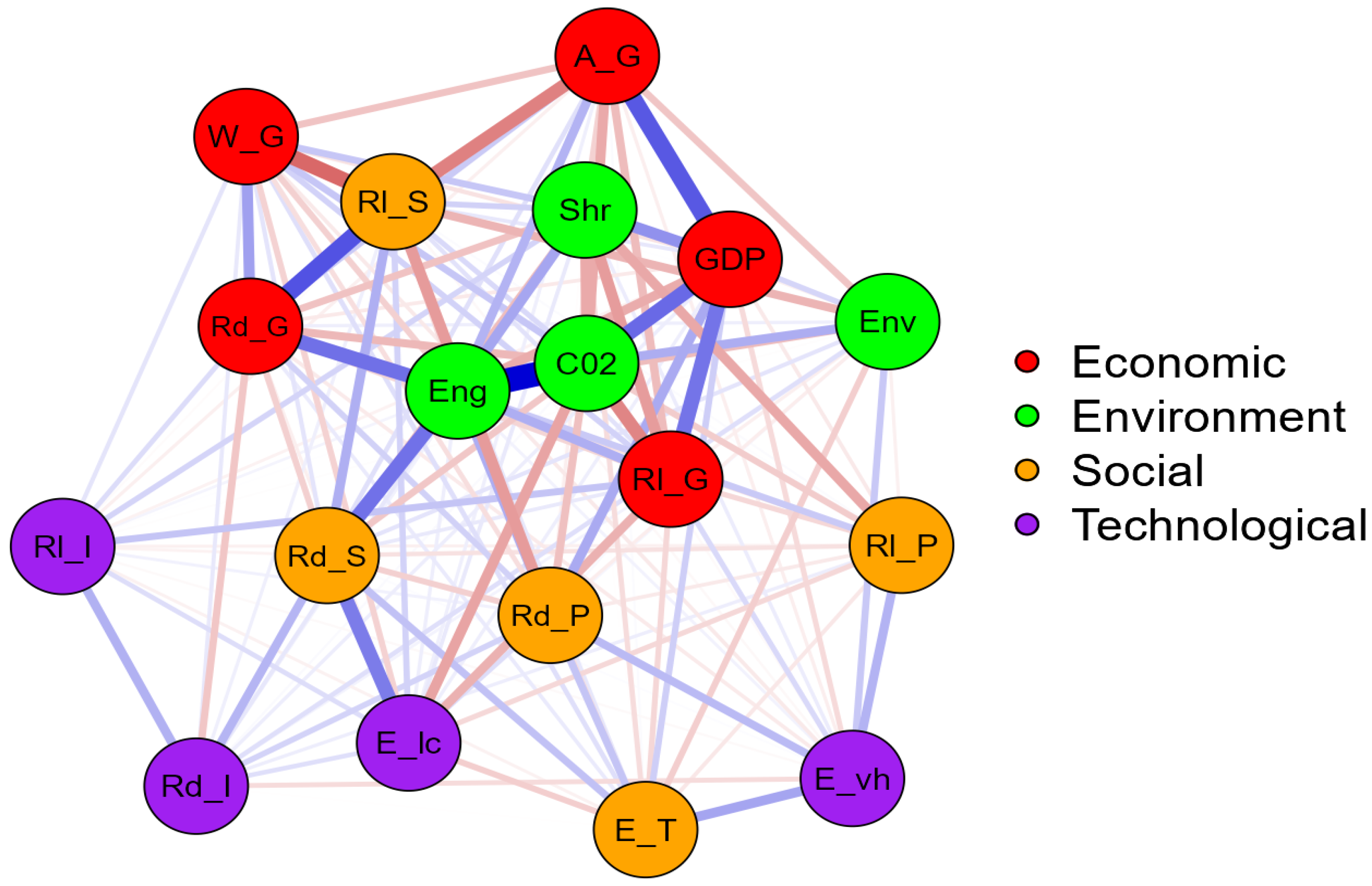Sustainable Transport in the European Union: Exploring the Net-Zero Transition through Confirmatory Factor Analysis and Gaussian Graphical Modeling
Abstract
:1. Introduction
2. Literature Review
3. Materials and Methods
3.1. The Dimensions of Transport Sustainability Included in the Analysis
3.2. Data
3.3. Methodology
4. Results
5. Discussion
6. Conclusions
Author Contributions
Funding
Data Availability Statement
Acknowledgments
Conflicts of Interest
Appendix A
| Variables | Network | |||||||||||||||||
|---|---|---|---|---|---|---|---|---|---|---|---|---|---|---|---|---|---|---|
| GDP | Rl_G | Rd_G | W_G | A_G | Env | CO2 | Shr | Eng | Rl_S | Rd_S | E_T | Rl_P | Rd_P | Rd_I | Rl_I | E_vh | E_lc | |
| GDP | 0.000 | 0.438 | −0.069 | −0.091 | 0.528 | 0.134 | 0.473 | 0.349 | −0.263 | 0.074 | −0.177 | 0.155 | −0.012 | 0.268 | 0.058 | −0.042 | −0.118 | 0.055 |
| Rl_G | 0.438 | 0.000 | −0.133 | 0.142 | −0.213 | −0.051 | −0.385 | −0.314 | 0.258 | 0.090 | 0.070 | −0.127 | −0.126 | 0.017 | 0.037 | 0.187 | 0.121 | −0.247 |
| Rd_G | −0.069 | −0.133 | 0.000 | 0.301 | 0.167 | 0.054 | −0.225 | −0.192 | 0.452 | 0.547 | −0.148 | 0.066 | −0.092 | 0.144 | −0.181 | 0.109 | −0.068 | −0.050 |
| W_G | −0.091 | 0.142 | 0.301 | 0.000 | −0.189 | 0.004 | 0.180 | 0.181 | −0.149 | −0.476 | 0.085 | 0.102 | 0.007 | −0.105 | 0.072 | 0.087 | −0.070 | −0.143 |
| A_G | 0.528 | −0.213 | 0.167 | −0.189 | 0.000 | −0.183 | −0.269 | −0.142 | 0.240 | −0.398 | 0.097 | 0.012 | −0.069 | −0.052 | −0.019 | −0.051 | −0.053 | 0.051 |
| Env | 0.134 | −0.051 | 0.054 | 0.004 | −0.183 | 0.000 | 0.259 | −0.048 | −0.210 | −0.237 | 0.085 | −0.154 | −0.048 | −0.057 | 0.103 | −0.007 | 0.173 | 0.031 |
| CO2 | 0.473 | −0.385 | −0.225 | 0.180 | −0.269 | 0.259 | 0.000 | −0.269 | 0.806 | 0.120 | −0.074 | −0.004 | −0.162 | −0.198 | 0.017 | 0.003 | −0.015 | −0.287 |
| Shr | 0.349 | −0.314 | −0.192 | 0.181 | −0.142 | −0.048 | −0.269 | 0.000 | 0.282 | 0.144 | −0.208 | −0.111 | −0.275 | −0.006 | 0.043 | 0.135 | 0.061 | 0.070 |
| Eng | −0.263 | 0.258 | 0.452 | −0.149 | 0.240 | −0.210 | 0.806 | 0.282 | 0.000 | −0.111 | 0.450 | −0.105 | 0.172 | 0.258 | 0.077 | 0.034 | 0.041 | 0.055 |
| Rl_S | 0.074 | 0.090 | 0.547 | −0.476 | −0.398 | −0.237 | 0.120 | 0.144 | −0.111 | 0.000 | 0.253 | 0.076 | 0.013 | −0.316 | 0.052 | −0.012 | −0.023 | 0.141 |
| Rd_S | −0.177 | 0.070 | −0.148 | 0.085 | 0.097 | 0.085 | −0.074 | −0.208 | 0.450 | 0.253 | 0.000 | 0.195 | −0.095 | −0.150 | 0.233 | −0.042 | 0.010 | 0.413 |
| E_T | 0.155 | −0.127 | 0.066 | 0.102 | 0.012 | −0.154 | −0.004 | −0.111 | −0.105 | 0.076 | 0.195 | 0.000 | −0.075 | 0.185 | −0.004 | −0.045 | 0.283 | −0.154 |
| Rl_P | −0.012 | −0.126 | −0.092 | 0.007 | −0.069 | −0.048 | −0.162 | −0.275 | 0.172 | 0.013 | −0.095 | −0.075 | 0.000 | −0.071 | 0.057 | −0.047 | 0.239 | −0.123 |
| Rd_P | 0.268 | 0.017 | 0.144 | −0.105 | −0.052 | −0.057 | −0.198 | −0.006 | 0.258 | −0.316 | −0.150 | 0.185 | −0.071 | 0.000 | 0.140 | 0.044 | 0.219 | 0.109 |
| Rd_I | 0.058 | 0.037 | −0.181 | 0.072 | −0.019 | 0.103 | 0.017 | 0.043 | 0.077 | 0.052 | 0.233 | −0.004 | 0.057 | 0.140 | 0.000 | 0.247 | −0.114 | 0.102 |
| Rl_I | −0.042 | 0.187 | 0.109 | 0.087 | −0.051 | −0.007 | 0.003 | 0.135 | 0.034 | −0.012 | −0.042 | −0.045 | −0.047 | 0.044 | 0.247 | 0.000 | −0.020 | 0.107 |
| E_vh | −0.118 | 0.121 | −0.068 | −0.070 | −0.053 | 0.173 | −0.015 | 0.061 | 0.041 | −0.023 | 0.010 | 0.283 | 0.239 | 0.219 | −0.114 | −0.020 | 0.000 | −8.867 |
| E_lc | 0.055 | −0.247 | −0.050 | −0.143 | 0.051 | 0.031 | −0.287 | 0.070 | 0.055 | 0.141 | 0.413 | −0.154 | −0.123 | 0.109 | 0.102 | 0.107 | −8.867 | 0.000 |
Appendix B

References
- European Commission. Sustainable & Smart Mobility Strategy, Factsheet-The Transport and Mobility Sector, PDF ISBN 978-92-76-27370-7. 2020. Available online: https://ec.europa.eu/commission/presscorner/api/files/attachment/867229/Factsheet%20-%20The%20Transport%20and%20Mobility%20Sector.pdf.pdf (accessed on 4 March 2024).
- European Environmental Agency Database. Available online: https://www.eea.europa.eu/en/analysis/indicators/greenhouse-gas-emission-intensity-of (accessed on 4 March 2024).
- Djordjević, B.; Mane, A.S.; Krmac, E. Analysis of dependency and importance of key indicators for railway sustainability monitoring: A new integrated approach with DEA and Pearson correlation. Res. Transp. Bus. Manag. 2021, 41, 100650. [Google Scholar] [CrossRef]
- European Commission. Press Release Brussels, 9 October 2023, Commission Welcomes Completion of Key ‘Fit for 55’ Legislation, Putting EU on Track to Exceed 2030 Targets. IP/23/4754. 2023. Available online: https://ec.europa.eu/commission/presscorner/detail/en/IP_23_4754 (accessed on 4 March 2024).
- European Commission. Communication from the Commission to the European Parliament, the European Council, the Council, the European Economic and Social Committee and the Committee of the Regions; COM (2019) 640 Final; European Commission: Brussels, Belgium, 2019; pp. 1–24. [Google Scholar]
- European Commission. White Paper-Roadmap to a Single European Transport Area—Towards a Competitive and Resource Efficient Transport System; COM (2011) 144 Final; European Commission: Brussels, Belgium, 2011; pp. 1–31. [Google Scholar]
- Tzeiranaki, S.T.; Economidou, M.; Bertoldi, P.; Thiel, C.; Fontaras, G.; Clementi, E.L.; De Los Rios, C.F. The impact of energy efficiency and decarbonisation policies on the European road transport sector. Transp. Res. Part A Policy Pract. 2023, 170, 103623. [Google Scholar] [CrossRef]
- European Parliament. Directive 2009/28/EC of the European Parliament and of the Council of 23 April 2009 on the promotion of the use of energy from renewable sources and amending and subsequently repealing Directives 2001/77/EC and 2003/30/EC. Off. J. Eur. Union 2009, 140, 16–62. [Google Scholar]
- European Parliament. Directive (EU) 2018/2001 of the European Parliament and of the Council of 11 December 2018 on the promotion of the use of energy from renewable sources. Off. J. Eur. Union 2018, 328, 82–209. [Google Scholar]
- European Parliament. Directive 2012/27/EU of the European Parliament and of the Council of 25 October 2012 on energy efficiency, amending Directives 2009/125/EC and 2010/30/EU and repealing Directives 2004/8/EC and 2006/32/EC. Off. J. Eur. Union 2012, 315, 1–56. [Google Scholar]
- European Parliament. Directive (EU) 2018/2002 of the European Parliament and of the Council of 11 December 2018 amending Directive 2012/27/EU on energy efficiency. PE/54/2018/REV/1. Off. J. Eur. Union 2018, 328, 210–230. [Google Scholar]
- European Parliament. Directive 2009/33/EC of the European Parliament and of the Council of 23 April 2009 on the promotion of clean and energy-efficient road transport vehicles. Off. J. Eur. Union 2009, 120, 5–12. [Google Scholar]
- European Parliament. Regulation (EU) 2023/851 of the European Parliament and of the Council of 19 April 2023 amending Regulation (EU) 2019/631 as regards strengthening the CO2 emission performance standards for new passenger cars and new light commercial vehicles in line with the Union’s increased climate ambition. Off. J. Eur. Union 2023, 110, 5–20. [Google Scholar]
- European Parliament. Regulation (EU) 2023/1804 of the European Parliament and of the Council of 13 September 2023 on the deployment of alternative fuels infrastructure, and repealing Directive 2014/94/EU. Off. J. Eur. Union 2023, 234, 1–47. [Google Scholar]
- European Parliament. Regulation (EU) 2023/1805 of the European Parliament and of the Council of 13 September 2023 on the use of renewable and low-carbon fuels in maritime transport, and amending Directive 2009/16/EC. Off. J. Eur. Union 2023, 234, 48–100. [Google Scholar]
- European Parliament. Regulation (EU) 2023/2405 of the European Parliament and of the Council of 18 October 2023 on ensuring a level playing field for sustainable air transport (ReFuelEU Aviation). Off. J. Eur. Union 2023, 1–30. [Google Scholar]
- European Parliament. Directive (EU) 2023/1791 of the European Parliament and of the Council of 13 September 2023 on energy efficiency and amending Regulation (EU) 2023/955 (recast). Off. J. Eur. Union 2023, 231, 1–111. [Google Scholar]
- European Parliament. Directive (EU) 2023/2413 of the European Parliament and of the Council of 18 October 2023 amending Directive (EU) 2018/2001, Regulation (EU) 2018/1999 and Directive 98/70/EC as regards the promotion of energy from renewable sources, and repealing Council Directive (EU) 2015/652. Off. J. Eur. Union 2023, 1–77. [Google Scholar]
- European Commission. Proposal for a Regulation of the European Parliament and of the Council on the Use of Railway Infrastructure Capacity in the Single European Railway Area, Amending Directive 2012/34/EU and Repealing Regulation (EU) No 913/2010; COM (2023) 443/2; European Commission: Brussels, Belgium, 2023. [Google Scholar]
- European Commission. Proposal for a Council Directive Restructuring the Union Framework for the Taxation of Energy Products and Electricity (Recast); COM/2021/563 Final; European Commission: Brussels, Belgium, 2021. [Google Scholar]
- Vir’ag, D.; Wiedenhofer, D.; Baumgart, A.; Matej, S.; Krausmann, F.; Min, J.; Haberl, H. How much infrastructure is required to support decent mobility for all? An exploratory assessment. Ecol. Econ. 2022, 200, 107511. [Google Scholar] [CrossRef]
- Gruetzmacher, S.B.; Vaz, C.B.; Ferreira, A.P. Sustainability performance assessment of the transport sector in European countries. Rev. Fac. Ing. Univ. Antioq. 2022, 104, 42–52. [Google Scholar] [CrossRef]
- Sztangret, I. Systemic Sustainable Development in the Transport Service Sector. Sustainability 2020, 12, 9525. [Google Scholar] [CrossRef]
- Ayadi, H.; Benaissa, M.; Hamani, N.; Kermad, L. Selecting Indicators to Assess the Sustainability of Urban Freight Transport Using a Multi-Criteria Analysis. Logistics 2024, 8, 12. [Google Scholar] [CrossRef]
- Ayadi, H.; Benaissa, M.; Hamani, N.; Kermad, L. Conceptual Framework for Assessing Sustainability of Urban Freight Transport. IFAC-Pap. 2022, 55, 251–256. [Google Scholar] [CrossRef]
- Pathak, D.K.; Shankar, R.; Choudhary, A. Performance assessment framework based on competitive priorities for sustainable freight transportation systems. Transp. Res. Part D Transp. Environ. 2021, 90, 102663. [Google Scholar] [CrossRef]
- Dillman, K.J.; Heinonen, J.; Davíðsdottir, B. A development of intergenerational sustainability indicators and thresholds for mobility system provisioning: A socio-ecological framework in the context of strong sustainability. Environ. Sustain. Indic. 2023, 18, 100240. [Google Scholar] [CrossRef]
- World Commission on Environment and Development. Our Common Future; Oxford University Press: Oxford, UK, 1987; pp. 1–247. ISBN 019282080X. [Google Scholar]
- Ayadi, H.; Benaissa, M.; Hamani, N.; Kermad, L. Assessing the Sustainability of Transport Systems through Indexes: A State-of-the-Art Review. Sustainability 2024, 16, 1455. [Google Scholar] [CrossRef]
- Georgatzi, V.; Stamboulis, Y.; Vetsikas, A. Examining the determinants of CO2 emissions caused by the transport sector: Empirical evidence from 12 European countries. Econ. Anal. Policy 2020, 65, 11–20. [Google Scholar] [CrossRef]
- Khurshid, A.; Khan, K.; Cifuentes, F.J. Agenda of sustainable transport: Can current progress lead towards carbon neutrality? Transp. Res. Part D Transp. Environ. 2023, 122, 103869. [Google Scholar] [CrossRef]
- Kwilinski, A.; Oleksii, L.; Pimonenko, T. Reducing transport sector CO2 emissions patterns: Environmental technologies and renewable energy. J. Open Innov. Technol. Mark. Complex. 2024, 10, 100217. [Google Scholar] [CrossRef]
- Alataş, S. Do environmental technologies help to reduce transport sector CO2 emissions? Evidence from the EU15 countries. Res. Transp. Econ. 2022, 91, 101047. [Google Scholar] [CrossRef]
- Williams, D.R. Bayesian Hypothesis Testing for Gaussian Graphical Models: Conditional Independence and Order Constraints. J. Math. Psychol. 2020, 99, 102441. [Google Scholar] [CrossRef]
- Hevey, D. Network analysis: A brief overview and tutorial. Health Psychol. Behav. Med. 2018, 6, 301–328. [Google Scholar] [CrossRef]
- Heidari, I.; Eshlaghy, A.T.; Hoseini, S.M.S. Sustainable transportation: Definitions, dimensions, and indicators—Case study of importance-performance analysis for the city of Tehran. Heliyon 2023, 9, e20457. [Google Scholar] [CrossRef]
- Schroten, A.; Van Grinsven, A.; Tol, E.; Leestemaker, L.; Schackmann, P.P.; Vonk-Noordegraaf, D.; Van Meijeren, J.; Kalisvaart, S. Research for TRAN Committee—The Impact of Emerging Technologies on the Transport System; European Parliament, Policy Department for Structural and Cohesion Policies: Brussels, Belgium, 2020. [Google Scholar]
- Janic, C. Sustainable Transport in the European Union: A Review of the Past Research and Future Ideas. Transp. Rev. 2006, 26, 81–401. [Google Scholar] [CrossRef]
- European Commission. Glossary for Transport Statistics, 5th ed.; European Commission: Brussels, Belgium, 2019; ISSN 2315-0815. [Google Scholar] [CrossRef]
- Eurostat Database. 2024. Available online: https://ec.europa.eu/eurostat/ (accessed on 5 March 2024).
- Juhari, M.L.; Arifin, K. Validating measurement structure of materials and equipment factors model in the MRT construction industry using Confirmatory Factor Analysis. Saf. Sci. 2020, 131, 104905. [Google Scholar] [CrossRef]
- Hair, J.F.; Black, W.C.; Babin, B.J.; Anderson, R.E. Multivariate Data Analysis, 7th ed.; Pearson Education Limited: Edinburgh Gate, UK, 2014. [Google Scholar]
- Suwartono, C.; Bintamur, D. Validation of the Emotion Regulation Questionnaire (ERQ): Network Analysis as an Alternative of Confirmatory Factor Analysis (CFA). ANIMA Indones. Psychol. J. 2019, 34, 115–1124. [Google Scholar] [CrossRef]
- Zoccolotti, P.; Angelelli, P.; Marinelli, C.V.; Romano, D.L. A network analysis of the relationship among reading, spelling and maths skills. Brain Sci. 2021, 11, 656. [Google Scholar] [CrossRef] [PubMed]
- Epskamp, S.; Fried, E.I. A Tutorial on Regularized Partial Correlation Networks. Psychol. Methods 2018, 23, 617–634. [Google Scholar] [CrossRef] [PubMed]
- Noja, G.G.; Cristea, M.; Panait, M.; Trif, S.M.; Ponea, C.S. The Impact of Energy Innovations and Environmental Performance on the Sustainable Development of the EU Countries in a Globalized Digital Economy. Front. Environ. Sci. 2022, 10, 934404. [Google Scholar] [CrossRef]
- Goss-Sampson, M.A. Statistical Analysis in JASP 0.16.1: A Guide for Students. 2022. Available online: https://jasp-stats.org/wp-content/uploads/2022/04/Statistical-Analysis-in-JASP-A-Students-Guide-v16.pdf. (accessed on 18 March 2024).
- De Flander, K.; Brugmann, J. Pressure-Point Strategy: Leverages for Urban Systemic Transformation. Sustainability 2017, 9, 99. [Google Scholar] [CrossRef]
- Pyra, M. Simulation of the Progress of the Decarbonization Process in Poland’s Road Transport Sector. Energies 2023, 16, 4635. [Google Scholar] [CrossRef]




| Research Areas Used from the Existing Literature | Originality of the Paper | ||
|---|---|---|---|
| Assessment of Transport Sustainability Performance | Causal Dependence Analysis between Transport Sustainability Determinants | ||
| Research objectives | Assess the status (performance) and progress of transport sustainability. | Estimate the isolated impact of different determinants on the level of transport emissions. | Analysis of the global interdependencies/relationships between the dimensions of sustainability and their determinants in the context of EU decarbonization policies. |
| Inputs | Sustainability dimensions: economic, environment, social, political, spatial, technological. | Determinants: economic growth; renewable energy; energy efficiency and consumption; green policies; environmental technologies; taxes. | Sustainability dimensions: economic, environment, social, technological. Sustainability determinants: content-related indicators of the four dimensions. |
| Outputs | Composite indexes of transport sustainability. Multiple indicators relevant for sustainability performance assessment. | Evidence about the direct links/relationships between different factors of influence and the level of emissions from transport modes. | Simultaneous evidence about the overall (direct, indirect and total) relationships between determinant factors of transport sustainability. |
| Sustainability Dimensions | Symbol | Specification | Source |
|---|---|---|---|
| Economic (Ecn) | GDP | Gross domestic product, as value of well-being per capita | Eurostat database |
| Rd_G | Volume of goods, in million ton-kilometer, transported by road | Eurostat database | |
| Rl_G | Freight transported by rail, volume of goods, in million ton-kilometer transported by rail | Eurostat database | |
| W_G | Unitization in maritime of freight transport, as million ton-kilometer | Eurostat database | |
| A_G | Freight transported by air Volume of goods, in tons, transported by air | Eurostat database | |
| E_T | Percentage of transport expenditure in total expenditure of households | Eurostat database | |
| Environmental (Envr) | CO2 | Tons of carbon dioxide (CO2) emissions from transportation | Eurostat database |
| Eng | Final energy consumption in transport, in tons of oil equivalent | Eurostat database | |
| Shr | Share of renewable energy in gross final energy consumption from transport | Eurostat database | |
| Env | Percentage of total revenues from transport taxes and social contributions (excluding imputed social contributions) | Eurostat database | |
| Social (Scl) | Rl_S | Number of rail accidents | Eurostat database |
| Rd_S | Persons killed in road accidents | Eurostat database | |
| Rl_P | Volume of passengers, in millions of passenger-kilometers, transported by rail | Eurostat database | |
| Rd_P | Volume of passengers, in millions of passenger-kilometers, transported by road | Eurostat database | |
| Technological (Tch) | Rl_I | Investments on rolling stock and railway infrastructure | Eurostat database |
| Rd_I | Investments on rolling stock and road infrastructure | Eurostat database | |
| E_lc | Electrical locomotives | Eurostat database | |
| E_vh | Electrical vehicle, as numbers of new zero-emission vehicles | Eurostat database |
| Variables | Men | St. Deviation | Skewness | Kurtosis | N |
|---|---|---|---|---|---|
| GDP | 26,583 | 17,289 | 1.532 | 2.644 | 270 |
| Rl_G | 14,803 | 13,630 | 1.708 | 6.223 | 270 |
| Rd_G | 68,523 | 66,730 | 2.025 | 3.125 | 270 |
| W_G | 10.611 | 9.680 | 0.923 | 0.046 | 270 |
| A_G | 144,113 | 214,429 | 2.506 | 5.580 | 270 |
| E_T | 12.174 | 2.066 | −0.569 | 1.663 | 270 |
| Env | 1.342 | 0.865 | 0.696 | −0.289 | 270 |
| CO2 | 15,536,143 | 15,144,461 | 2.021 | 3.751 | 270 |
| Shr | 7.661 | 5.050 | 1.366 | 5.746 | 270 |
| Eng | 10,175 | 10,037 | 1.988 | 2.860 | 270 |
| Rl_S | 61.789 | 57.590 | 1.953 | 3.412 | 270 |
| Rd_S | 798 | 145 | 1.557 | 0.981 | 270 |
| Rl_P | 12,637 | 11,769 | 1.675 | 5.998 | 270 |
| Rd_P | 505.689 | 93.377 | −0.288 | −0.276 | 270 |
| Rd_I | 4578 | 947 | 1.009 | 2.793 | 270 |
| Rl_I | 2205 | 1760 | 1.263 | 6.367 | 270 |
| E_vh | 15,208 | 11,310 | 1.658 | 3.157 | 270 |
| E_lc | 374 | 277 | 1.681 | 1.768 | 270 |
Disclaimer/Publisher’s Note: The statements, opinions and data contained in all publications are solely those of the individual author(s) and contributor(s) and not of MDPI and/or the editor(s). MDPI and/or the editor(s) disclaim responsibility for any injury to people or property resulting from any ideas, methods, instructions or products referred to in the content. |
© 2024 by the authors. Licensee MDPI, Basel, Switzerland. This article is an open access article distributed under the terms and conditions of the Creative Commons Attribution (CC BY) license (https://creativecommons.org/licenses/by/4.0/).
Share and Cite
Sichigea, M.; Cîrciumaru, D.; Brabete, V.; Barbu, C.M. Sustainable Transport in the European Union: Exploring the Net-Zero Transition through Confirmatory Factor Analysis and Gaussian Graphical Modeling. Energies 2024, 17, 2645. https://doi.org/10.3390/en17112645
Sichigea M, Cîrciumaru D, Brabete V, Barbu CM. Sustainable Transport in the European Union: Exploring the Net-Zero Transition through Confirmatory Factor Analysis and Gaussian Graphical Modeling. Energies. 2024; 17(11):2645. https://doi.org/10.3390/en17112645
Chicago/Turabian StyleSichigea, Mirela, Daniel Cîrciumaru, Valeriu Brabete, and Cătălin Mihail Barbu. 2024. "Sustainable Transport in the European Union: Exploring the Net-Zero Transition through Confirmatory Factor Analysis and Gaussian Graphical Modeling" Energies 17, no. 11: 2645. https://doi.org/10.3390/en17112645
APA StyleSichigea, M., Cîrciumaru, D., Brabete, V., & Barbu, C. M. (2024). Sustainable Transport in the European Union: Exploring the Net-Zero Transition through Confirmatory Factor Analysis and Gaussian Graphical Modeling. Energies, 17(11), 2645. https://doi.org/10.3390/en17112645






